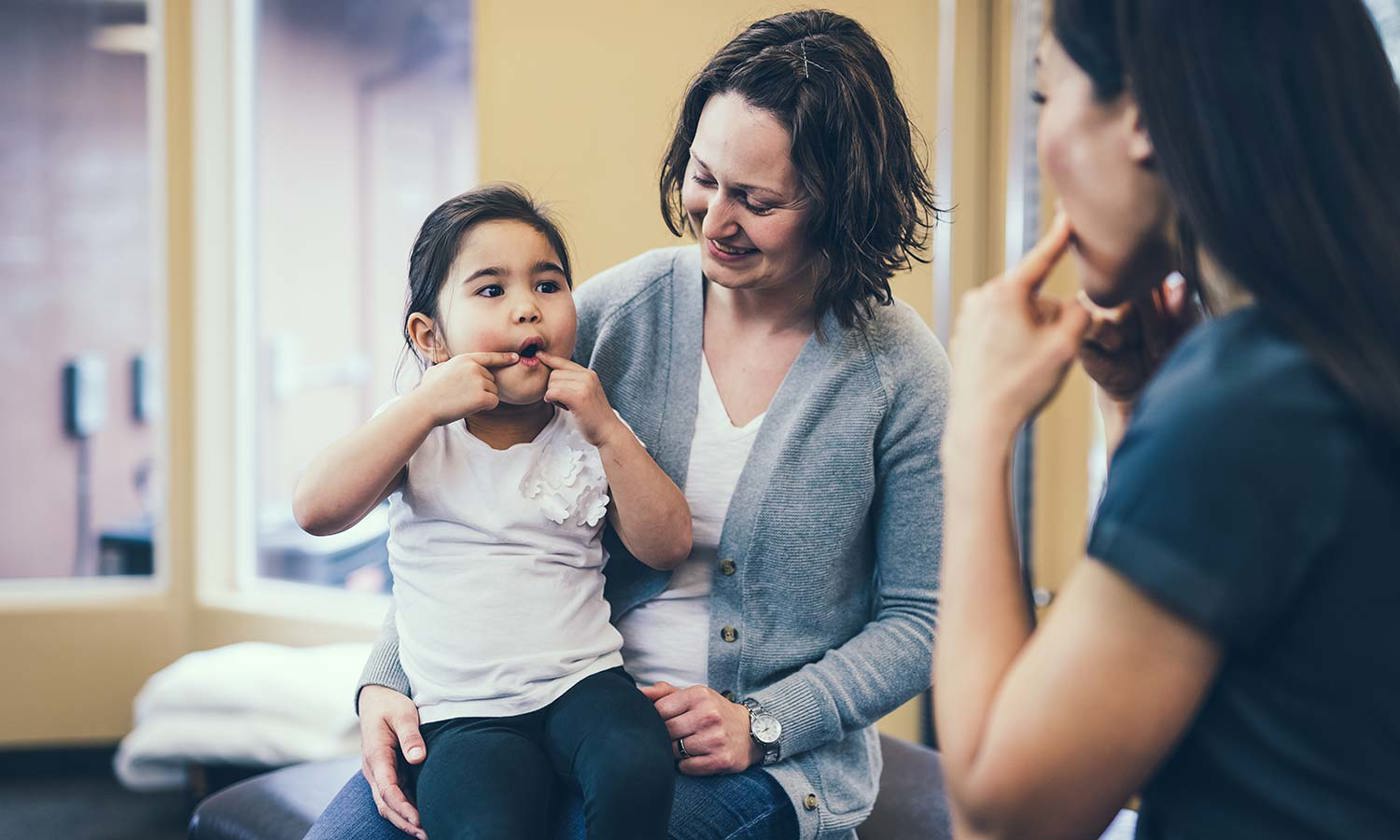Like what you see?
Sign up to receive more free parenting advice.
Thank you for subscribing to our newsletter!
Child Development

Credit: iStock.com/FatCamera
A series of studies1 funded by the Murdoch Children’s Research Institute is offering promise to parents concerned by their child’s stutter.
The research finds that while stuttering is more common than previously thought, four-year-old preschoolers who stutter aren’t more shy or withdrawn than their peers, in fact they have stronger expressive language skills than their peers; and stuttering doesn’t necessarily threaten their psychosocial health.
What is stuttering?
“Stuttering is a motor speech disorder characterised by three different types of behaviours,” says Dr Elaina Kefalianos, Lead of Teaching and Senior Lecturer in Speech Pathology at The University of Melbourne and one of the researchers for the studies.
“The first category is repetitive behaviours where children might repeat single sounds, part of words or whole words.
‘The second category of behaviours is prolongations, where the child will produce a sound or hold onto the sound for longer than is typical. For example, they may say ‘ssssschool’.
“The final category is called blocks. This is when a child will go to speak but no sound will be produced for a period of time, either very briefly or for a few seconds.”
Dr Kefalianos says that different children present with different combinations of the categories.
Stuttering typically starts between the ages of two and four years old.
“Stuttering onset most commonly coincides with a particular point in children’s language development. In the study, parents reported they noticed children beginning to stutter when children started to combine words, for example, putting two words together,” says Dr Kefalianos.
The research indicated that 65 per cent of children will recover from stuttering by age seven, and many of them will likely do so without receiving any form of intervention. But we don’t know who those children will be, so from that perspective, we recommend that all children who stutter receive therapy as soon as possible.Dr Elaina Kefalianos
Stay up to date with the latest news and articles from First Five Years
Thank you for subscribing to our newsletter!
How common is stuttering?
Previously, it was thought that five per cent of children between two and four years old were affected by stuttering, however, this figure is actually double.
“Stuttering is not part of typical development,” says Dr Kefalianos, “but it is actually very common. 11.2 per cent of children2 will go through a period of stuttering in the preschool years. Around two thirds of children who stutter will outgrow the stutter by the time they get to school.”
A 2014 study, Stuttering, Temperament, and Anxiety: Data From a Community Cohort Ages 2–4 Years which monitored 1,619 children, found that stuttering develops quite quickly, within one to three days.
Dr Kefalianos says that the cause is still unknown, but researchers are trying to figure this out.
What they do know is that there is a strong genetic link.
“Around two thirds of children who stutter will have a positive family history of stuttering, where at least one other person in their immediate or extended family stutter. For children with a positive family history of persistent stuttering, the likelihood of persisting with stuttering into adulthood [for that child] increases.”
Other common traits that Dr Kefalianos and her colleagues have found is that boys are more likely to stutter than girls and children who have stronger expressive language skills have a higher risk.
Dr Kefalianos points out that “there is a third of children who stutter who don’t have a positive family history of stuttering. For all children who stutter, current research is focusing on the structure and function of the brain.
“We are looking at the areas of the brain that are involved in enabling us to speak and looking at how the brain works in children who stutter and children who don’t stutter. We are trying to work out whether there is anything in the brain that shows difficulties when children who stutter are trying to communicate.”
“We are also looking at the recovery rate,” says Dr Kefalianos. In a 2017 study, The History of Stuttering by 7 Years of Age: Follow-Up of a Prospective Community Cohort, Dr Kefalianos and her colleagues found that 65 per cent of children, who were confirmed to have a stutter at the age of four, recovered by the age of seven years old.
By looking at the recovery rate researchers are hoping to find whether there are any indicators to suggest a child will be more likely to recover.
Busting the stuttering stereotype
There is a perceived stereotype that children who stutter are shy, don’t have good language skills and will go on to struggle at school.
However, the 2014 study dispelled these stereotypes.
According to the study, by age four, children who stuttered fared just as well or even better than their peers. They were not more shy than their peers and had stronger expressive language skills. The study also recommends that health and education professionals can reassure families that stuttering doesn’t threaten their child’s psychosocial health outcomes.
The real problem with stuttering is when there is a negative impact on the child’s communication.
“We know that the longer a child stutters and experiences stuttering, the more likely they are to experience negative reactions to stuttering,” says Dr Kefalianos.
“They can experience them intrinsically, so they may react negatively to the speech difficulties. Or they could experience them extrinsically where they experience negative reactions to their stuttering from other people.
“A lot of research indicates that there is a potential for children who stutter to experience these negative communication experiences.”
This is why Dr Kefalianos recommends seeking treatment for a child as soon as possible to avoid any negative associations with their stutter or speaking in general.
Seeking help
“The research indicated that 65 per cent of children will recover from stuttering by age seven, and many of them will likely do so without receiving any form of intervention,” says Dr Kefalianos.
“But we don’t know who those children will be, so from that perspective, we recommend that all children who stutter receive therapy as soon as possible.”
In the period between noticing stuttering in their child and going into a clinic to see a speech pathologist, Dr Kefalianos recommends to give children as much time to speak, “there is a temptation to try and finish their sentence for them, but that may lead to frustration for the child, so the best thing to do is to be patient and give them the extra time to finish saying what they want to say.”
“Try to not draw any attention to the stutter. Don’t comment on the stutter unless the child themselves comment on it and limit attention to it so the child remains as unaware as possible of the fact they are having difficulty speaking.”
Dr Kefalianos recommends asking what form of therapy the speech pathologist uses to treat stuttering. She notes that the Lidcombe Program has the highest level of evidence for its effect on stuttering.
“The Lidcombe program involves the parent and the child coming in to see a speech pathologist on a weekly basis. During those appointments the speech pathologist trains the parent to deliver the therapy, so the parent can deliver the therapy with the child at home on a daily basis for around 15 minutes.
“It is based on the principle of behavioural reinforcement which means that the parent (during treatment time) is praising the child for stutter free sentences and in some cases applying very subtle corrections to stuttered sentences. The idea being that when you praise a particular behaviour it increases the frequency of that behaviour.
“Through that process, the child practices more and more stutter-free speech and that causes a generalisation effect for the child’s everyday speech, so they become more fluent throughout the day until the stuttering is minimised or completely eliminated.”
1 Elaina Kefalianos, Mark Onslow, Obioha Ukoumunne, Susan Block, and Sheena Reilly, (August 2014) Stuttering, Temperament, and Anxiety: Data From a Community Cohort Ages 2–4 Years, Journal of Speech, Language, and Hearing Research, Vol. 57, 1314-1322. https://jslhr.pubs.asha.org/article.aspx?articleid=1833526 & Elaina Kefalianos, Mark Onslow, Ann Packman, Adam Vogel, Angela Pezic, Fiona Mensah, Laura Conway, Edith Bavin, Susan Block, and Sheena Reilly, (October 2017), The History of Stuttering by 7 Years of Age: Follow-Up of a Prospective Community Cohort, Journal of Speech, Language, and Hearing Research, Vol. 60, 2828-2839. https://jslhr.pubs.asha.org/article.aspx?articleid=2657162
2 Sheena Reilly, Mark Onslow, Ann Packman, Melissa Wake, Edith L. Bavin, Margot Prior, Patricia Eadie, Eileen Cini, Catherine Bolzonello, Obioha C. Ukoumunne, (January 2009), Predicting Stuttering Onset by the Age of 3 Years: A Prospective, Community Cohort Study, Pediatrics http://pediatrics.aappublications.org/content/123/1/270





